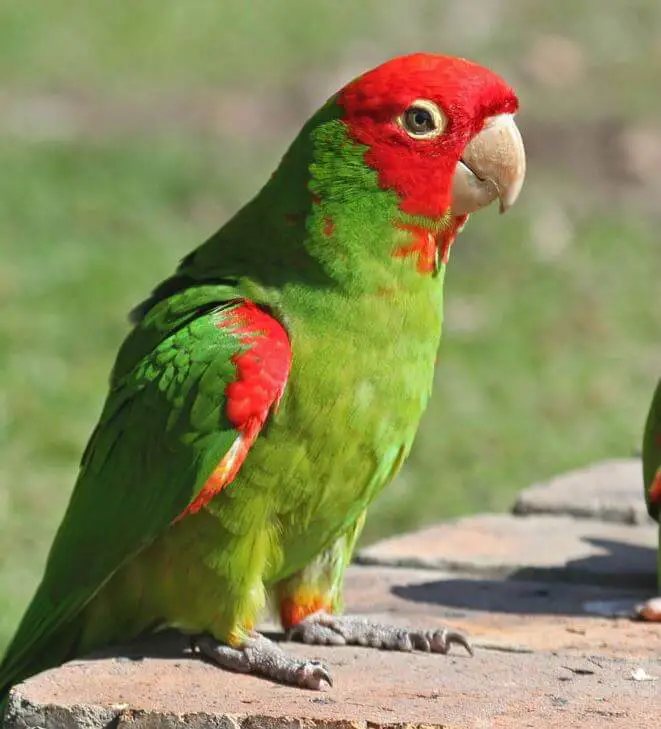Red-Masked Conure ( Psittacara erythrogenys ) is a medium-sized species of parrot in the genus Psittacara, native to western Ecuador and northwestern Peru.
The Guayaquil Parakeet is also sometimes called the Red-crowned Parakeet, but more often it refers to another species of parrot, Pyrrhura rhodocephala, in the Red-tailed Parakeet genus.
Named Guayaquil, the capital of the Ecuadorian province of Guayas, the parrot still performed there in the thousands in the 1970s.
Due to local and international trade and presumably also due to habitat loss, the population of the animals has declined sharply. No flock of more than 200 birds has been observed since 1987.
Outside of Ecuador and Peru, feral offspring of captive escapees are found in Spain, Mexico, and the United States.
The animals that live in San Francisco are the subject of the 2003 documentary The Wild Parrots of Telegraph Hill by Judy Irving.
Personality
Adult Guayaquil parrots reach a length of around 33 centimeters. Males and females do not differ externally.
The top of the head is red, the eye rings are white and bare. Most of the rest of the body and the wings are green, the belly yellowish.
The arm-coverts, the outer under-wing-coverts, and the lower thighs are red. The undersides of the wings and tail are olive-yellow. Juvenile animals largely lack red coloration.
SOURCE: Nature Media
Vocalizations
The Red-Masked Conure’s voice is described as “nasally squeaky”. In flight, especially in a swarm, the animals make loud screeching calls.
Distribution and Habitat

The distribution area of the Red-Masked Conure extends along the South American Pacific coast in a north-south direction from the province of Manabí in northwestern Ecuador to Lambayeque in northwestern Peru.
In addition, the Red-Masked Conureis found in the provinces of Pichincha , Los Ríos , Guayas, Azuay, El Oro, and Loja of Ecuador, and in the regions of Tumbes , Piura , and Cajamarcawidespread in Peru.
The distribution area extends from sea level to an altitude of 2,500 meters, with most animals being found at an altitude of around 1,500 meters.
Habitats of the Red-Masked Conure range from tropical rain forests, deciduous forests, and areas covered with acacia bushes to largely open and arid areas.
In addition, the Red-Masked Conure can be found on the outskirts of cities and in intensively agricultural regions.
Diet
Little is known about the feeding habits of the Red-Masked Conure. The choice of food is probably highly dependent on the respective habitat and the season.
The fruits of plants from the families of the sumac family (Anacardiaceae), borage family ( Boraginaceae ), and Olacaceae are used as animal food.
In southwestern Ecuador, Guayaquil parrots have been observed feeding on coral tree blossoms when fruit was scarce.
Red-masked Parakeet Calls
SOURCE: American Bird Conservancy
Reproduction
Breeding takes place in tree cavities (such as Ceiba trischistandra or Cochlospermum vitifolium ) or in termite mounds.
In the Tumbes region of Peru, the breeding season begins between March and April and ends in July. In Ecuador, the breeding season extends from January to March.
Nests are built 2.5 to 10 meters above the ground, often in natural tree cavities made by fallen branches.
The clutch consists of two to four eggs. Captive animals incubate the eggs for an average period of 23 days, with nestlings leaving the nest six weeks after hatching.
Conservation status
Red-Masked Conures in San Francisco
The International Union for Conservation of Nature and Natural Resources (IUCN) classifies the Red-Masked Conure as “Near Threatened” (NT).
Populations are suffering greatly from local trade in Peru and Ecuador, where animals are sought after as pets.
However, as with other species of New World parrots, international trade is assumed to be the main reason for the decline in numbers.
A study commissioned by the CITES Secretariat in 1992 put the total number of animals exported from 1983 to 1988 at nearly 52,000, with the United States alone accounting for more than 44,000.
The loss of habitats due to deforestation is assumed to be another reason for the decline in population. Exact studies on the extent to which the Red-Masked Conure is dependent on forests are still pending.
In the United States, captive escapees have been bred in various California cities, although the exact size of the populations is unknown.

